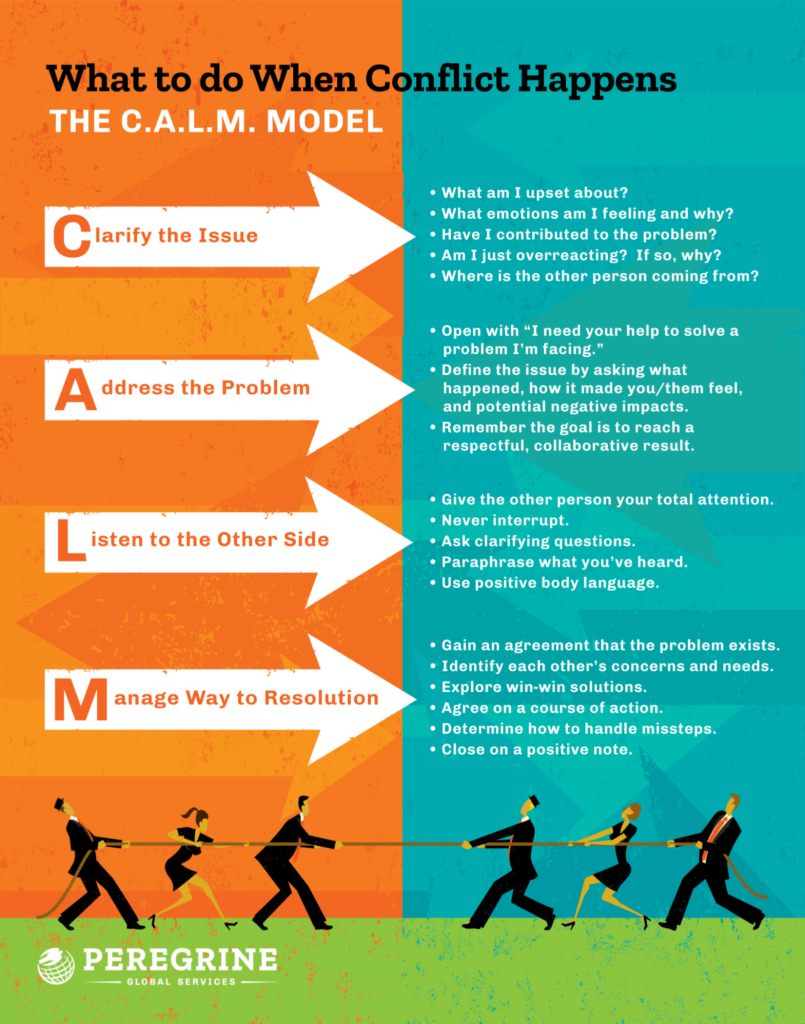Let’s say you work in a busy restaurant as a manager. You have a direct report, Susie, who is always late and frequently forgets orders. Because of her carelessness, customers often complain, which means you are responsible for hearing those customers’ concerns and finding ways to make it up to the customer. As a new supervisor, you are responsible for talking to her about her performance. However, you’re nervous. You want to maintain a good working relationship with Susie but are worried the conversation might go south. You consider potentially ignoring the situation altogether. You are much more comfortable dealing with unhappy customers than engaging in conflict with team members. But, you need to get comfortable with resolving conflict at work.
Good conflict management skills are essential at every level within the workplace. Unfortunately, you can’t avoid conflict. It is inevitable and not always a terrible thing. If you chose to avoid talking to Susie, she would never know to improve, which isn’t exactly fair to Susie.
From differences in opinions, goals, values, and communication styles, conflicts can arise at any time. Therefore, learning how to identify, manage, and resolve conflict effectively in the workplace is essential.
What is conflict management?
Conflict management is a process of solving disputes and clashes between individuals or groups in the workplace. It involves understanding the sources of conflict, the different perspectives of the parties involved, and developing strategies to solve the conflict. Effective conflict management helps maintain a positive work environment, enhances relationships, increases productivity, and creates a more cohesive team.
Causes of conflict in the workplace
Each situation will be unique, but workplace conflict often will result from one or more of the following. In the example with Susie, it could be that Susie experiences scarcity. Maybe she doesn’t have reliable transportation, and the stress reduces her ability to focus at work. Or maybe it is a case of poor communication, and Susie doesn’t realize she isn’t meeting expectations. Your job is to find out.
Seek first to understand, then to be understood
Stephen R. Covey
- Poor communication – Communication breakdowns, misunderstandings, or misinterpretations can lead to conflicts.
- Differences in personality – Different personality traits can result in disagreements.
- Unmet expectations – Unrealistic goals or expectations can cause frustration, leading to conflicts.
- Power struggles – Power struggles may ensue when there is a lack of authority or control.
- Scarce resources – Competition for limited resources like time, budget, or technology can cause tension and conflicts.
- Discrimination – Discrimination based on cultural, gender, racial, or age differences can result in conflicts.
Five tips for dealing with conflict at work
- Stay calm – Conflict can be emotional, but it’s important to stay calm and level-headed when dealing with it. Take a deep breath, count to ten, and try to approach the situation objectively. Don’t let your emotions get the best of you – it will only make the situation worse.
- Listen actively – Listening is one of the most important skills when it comes to conflict resolution. Make sure you listen actively to the other person’s point of view and try to understand their perspective. Don’t interrupt, and don’t dismiss their opinions.
- Communicate effectively – Good communication is key to resolving conflict at work. Use “I” statements when expressing your own feelings and opinions and avoid blaming or accusing language. Be clear and concise when stating your position and ask for clarification if you’re unsure of what the other person means.
- Find common ground – When dealing with conflict, look for areas of agreement or common ground. This can help build rapport and create a positive atmosphere. Focus on finding solutions that work for both parties, rather than trying to “win” the argument.
- Seek advice – If you’re struggling to resolve a conflict, don’t be afraid to seek advice from a trusted colleague, mentor, or supervisor. They may be able to offer a fresh perspective or suggest strategies that you haven’t considered.

A simple and easy to remember model for addressing conflict is the C.A.L.M. Model. Fill out the form to download, your free copy of the C.A.L.M. Model poster.
Resolving conflict at work
Now that you have the tools to identify conflict and a model to help you resolve the issue, let’s revisit Susie and what conflict management would look like in that specific instance
- Stay calm: Take a deep breath before approaching Susie. Remember that she’s probably not intentionally causing problems and try to approach the situation in a calm and objective manner.
- Listen actively: When you talk to Susie, listen to her point of view. She may have valid reasons for being late or making mistakes. Try to understand why she’s struggling.
- Communicate effectively: Use “I” statements to express your concerns. For example, say something like, “I’ve noticed that some customers have been complaining about their orders being incorrect. Can we talk about ways to make sure this doesn’t happen?”
- Find common ground: Focus on finding solutions that work for both you and Susie. Maybe she can ride with a coworker if transportation is an issue. Or you might have enough flexibility to schedule her for a later shift. To resolve the customer issue, you can offer to help double-check orders before they go out.
- Seek advice: If you’re still struggling to resolve the issue, consider talking a more experienced colleague for advice. They may be able to offer suggestions or strategies that you haven’t thought of.

Managing Conflict
Need more tools in your toolbox to help you learn to manage conflict?
In this course, you will learn the art of conflict resolution. You will examine different kinds of conflict and how to best deal with them, including what to do when conflict happens, how to minimize or remove barriers to conflict resolution, how to handle high maintenance relationships, and some tried-and-true rules for conflict resolution.
Learn more or click below to add the course to your cart.
[commerce Item=148]


